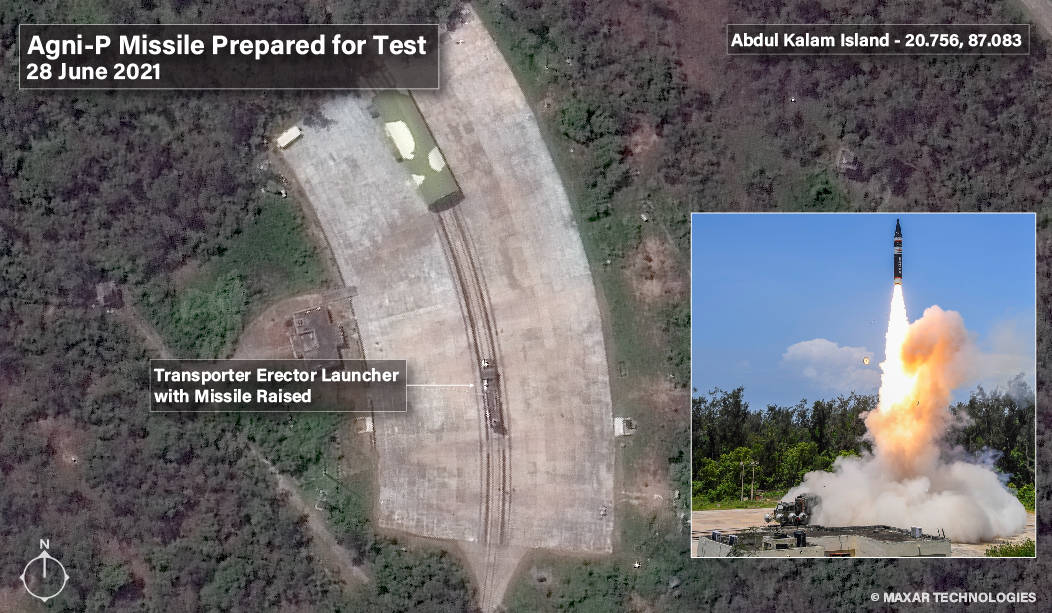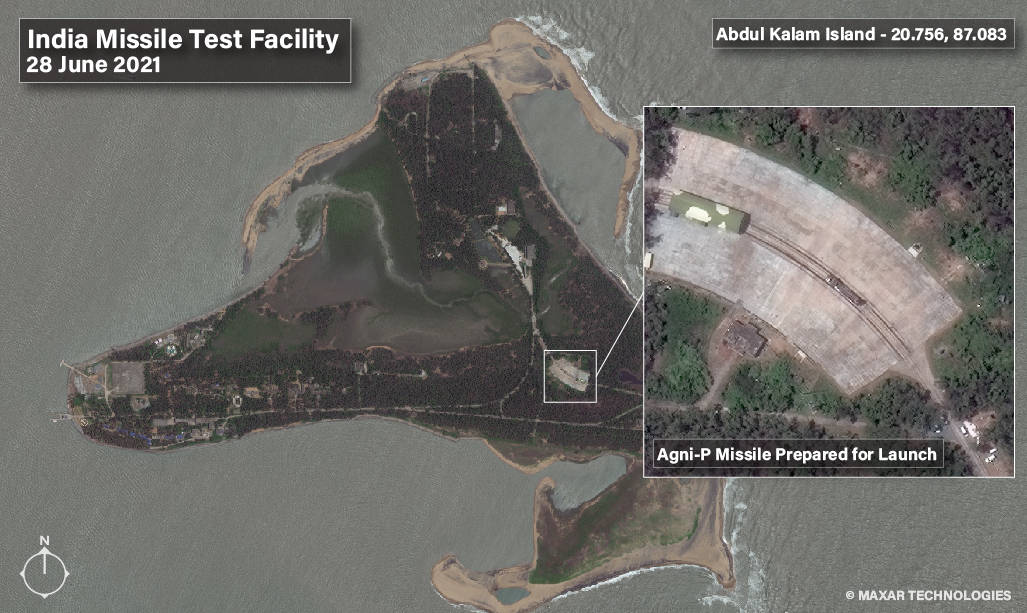India’s Nuclear Doctrine: The Agni-P and the Stability–Instability Paradox
The recent Agni-P missile represents a step towards what some see as a nascent Indian nuclear counterforce capability. The erosion of India’s doctrinal commitment to minimum deterrence carries important lessons regarding strategic stability.
The recent Indian test launch of the Agni-P, a medium-range ballistic missile with a 2000 km range, raises questions about the future of Indian nuclear doctrine, with ramifications both for the Indian subcontinent and beyond. The missile, which shows a growing Indian emphasis on accuracy and the ability to conduct prompt strikes, could represent a step in India’s gradual doctrinal evolution towards a counterforce posture. This evolution, and the circumstances which have precipitated it, has ramifications for the analysis of nuclear dynamics both in the region and beyond.
Figure 1: India’s New Agni-P Missile Prepped for Launch

Characteristics of the Agni-P
The Agni-P is of little relevance to scenarios involving China, given that China’s densely populated coastal provinces are out of its range, particularly if it is launched from safe positions deep within India. Scenarios involving Pakistan seem to have driven the development of the missile, which makes several of its characteristics particularly notable.
First, the two-stage missile, which receives satellite guidance and has a reported circular error probable (a measure of accuracy) of 10 metres, continues a trend in Indian defence procurement which emphasises precision. This is also reflected in concerted investment in radar and optical correlation guidance. This is noteworthy given that these levels of accuracy are unnecessary for the minimum deterrent countervalue mission that has historically been closely linked to India’s ‘no-first use’ doctrine. The role of nuclear forces in this doctrine has been to deter nuclear use against India by threatening to inflict unacceptable damage on an opponent’s cities. Beyond deterring the use of nuclear weapons against one’s own population, however, nuclear weapons have little role in a minimum deterrent doctrine. As the targets are cities rather than military assets, the missiles do not need high precision levels.
Second, the missile is canisterised and rail-mobile. Cold launches of canisterised missiles, which are enabled by the use of solid fuel propellant, allow the conduct of strikes from any terrain at short notice. Notably, canisterised missiles are stored with their warheads in peacetime. This represents a break from the previous Indian policy of storing warheads separately from missiles and enables a strike posture that leaves an opponent with short warning times.
Figure 2: The Missile Test Facility on Abdul Kalam Island

When viewed in conjunction with other developments – such as India’s investment in a more robust ISR network, and its development of other prompt strike capabilities like the BrahMos cruise missile and the hypersonic Shaurya missile – the fielding of the Agni-P could be viewed as the harbinger of a transition towards a counterforce posture aimed at neutralising Pakistan’s nuclear arsenal in the early stages of a conflict.
Indian Incentives for Counterforce
A major source of frustration for Indian planners over the last several decades has been the ability of Pakistan’s more flexible nuclear posture to nullify India’s conventional military advantages and thus enable Pakistan to conduct proxy warfare against India at limited risk. Pakistan’s stated willingness to resort to nuclear first use in a conventional conflict has played an important role in deterring Indian retaliation in the wake of incidents such as the 2001 attack on India’s Parliament and the 2008 Mumbai attacks – both of which India attributed to groups backed by Pakistan’s intelligence agencies. This threat has been buttressed by concerted investment in a range of low-yield nuclear capable systems including air-launched tactical nuclear weapons and, more recently, the Nasr short-range ballistic missile.
In essence, Indian planners have to contend with the fact that if they respond to a Pakistan-backed terrorist attack with a conventional armoured thrust, the forces conducting punitive conventional operations may be attacked with nuclear weapons. The threat to use battlefield nuclear weapons against Indian forces, while holding Pakistan’s strategic nuclear weapons in reserve, causes a dilemma for Indian planners. Responding to the use of tactical nuclear weapons by retaliating against Pakistani cities, a response consistent with a minimum deterrence posture, would be both disproportionate and would represent a hollow threat against an opponent that can use its strategic arsenal to retaliate in kind. A limited tit-for-tat response against a military asset, while theoretically viable, raises the prospect of an escalatory cycle which could spiral out of control.
This has prompted a great deal of public discussion about the utility of India’s nuclear posture, with the former defence minister Manohar Parrikar questioning the validity of ‘no first use’ and minimum deterrence. This occurred on the back of efforts to practice firing submarine-launched ballistic missiles on depressed trajectories which, by virtue of being shorter than a conventional ballistic trajectory, limit a missile’s flight time and thus an opponent’s warning times. Collectively, the evidence suggests that a counterforce posture is now being seriously considered. Such a posture would entail targeting Pakistan’s tactical and strategic nuclear arsenals, with a particular emphasis on the latter. The ability to unilaterally threaten strategic nuclear use following the elimination of Pakistani strategic response options could restore the credibility of India’s deterrent posture.
Given the relatively limited size of the Pakistani nuclear arsenal, the fact that a portion of this arsenal is dedicated to shorter-range battlefield roles and the limited geographical depth of Pakistan, counterforce might represent a viable option for India in the event of a conflict. Short-range ballistic missiles, such as the Prahaar and Prithvi, hold Pakistan’s 11 main airbases, as well as some of its corps commands (which have a role in Pakistan’s nuclear decision-making), at risk with limited warning times. Accurate medium-range nuclear capable assets such as the Agni-P raise the prospect of India being able to target the hardened storage sites which host Pakistan’s strategic systems, as well as all of the country’s corps commands and other C2 nodes. Finally, if cued in a timely manner, conventional systems, such as the land attack variant of the BrahMos, can responsively attack soft targets including nuclear-weapons capable aircraft like the F-16 while they are on the ground, and as Indian maritime assets target Pakistan’s limited sea-based deterrent. This would impose taxing demands on India’s ISR systems but improvements in areas such as space-based ISR render this approach less implausible than would once have been the case. While a portion of Pakistan’s arsenal would likely survive a first strike, India’s investments in both domestic ballistic missile defence (BMD) systems and imported BMD capable systems, like the Barak-8 and the S-400, could eventually neutralise the threat to major urban centres posed by an already attritted arsenal should a first strike be successful.
To be sure, this does not conclusively prove that India has already adopted a full-blown counterforce posture. Its arsenal of nuclear-capable ballistic missiles is smaller than would typically be expected for a country contemplating counterforce, even though nuclear attacks could be augmented with conventional strikes. There are also drivers of the emphasis on developing accurate systems rooted in organisational prestige and bureaucratic politics.
Moreover, there are open questions regarding the viability of a counterforce posture. Though Indian BMD systems could protect the country’s capital and, in time, at least some other major cities, the sheer number of heavily populated urban centres in India would raise the prospect of effective retaliation by the remnants of Pakistan’s nuclear arsenal. Of course, should defence planners in Pakistan treat the ability to strike on Delhi as essential (much as the UK did during the Cold War with its ‘Moscow criterion’) then the ability to threaten effective counterforce, coupled with the credible defence of a select list of key cities, may be sufficient for deterrence.
It may be the case that Indian policy is still in flux, or that cultivating a degree of ambiguity regarding a likely Indian response is deemed a useful restraint on Pakistani crisis behaviour, even if India does not intend to inflict a crippling first strike in a conflict scenario. What is clearer, however, is that the historic Indian commitment to minimum deterrence is wavering, and that India increasingly has the capacity to make a doctrinal shift if it wants. This carries a number of lessons for analysts both within and beyond the subcontinent.
At the heart of the strategic dilemma facing India is what the political scientist Glenn Snyder dubbed the stability–instability paradox. The more risky, and thus unlikely, large-scale conflict is, the more viable limited aggression becomes. While the nuclear balance that has prevailed on the subcontinent has limited the prospects for a full-scale war between its two nuclear armed powers, it has also prevented India from credibly using its superior capabilities to deter a range of hostile activities including proxy warfare and limited-aims territorial revisionism. This dynamic in turn incentivises the target state to adopt a highly risky counterforce posture – accepting the risk of instability at the highest levels of the escalation ladder to escape the reality of strategic paralysis in the face of persistent provocation.
This has salience beyond the subcontinent, given the similarities between Pakistan’s nuclear posture and the strategic posture of Russia. In a limited-aims conflict in Eastern Europe which triggers NATO alliance commitments, Russia is likely to resort to the threat or actual use of battlefield nuclear weapons to deter the materially superior alliance from responding to its actions. The erosion of the Indian commitment to minimum deterrence – once a mainstay of its strategic thinking – illustrates that, over the long term, policymakers facing regular provocations, underwritten by nuclear threats, may come to question currently accepted limitations on nuclear weapons use.
The views expressed in this Commentary are the authors', and do not represent those of RUSI or any other institution.
Have an idea for a Commentary you’d like to write for us? Send a short pitch to commentaries@rusi.org and we’ll get back to you if it fits into our research interests. Full guidelines for contributors can be found here.
WRITTEN BY
Dr Sidharth Kaushal
Senior Research Fellow, Sea Power
Military Sciences
James Byrne
RUSI Senior Associate Fellow, Military Sciences
Joe Byrne
Former RUSI Research Fellow
Gary Somerville
Former RUSI Research Fellow


